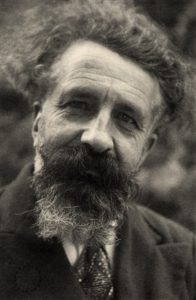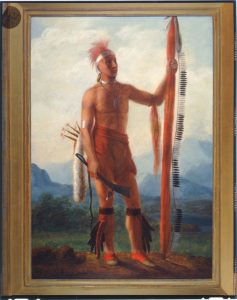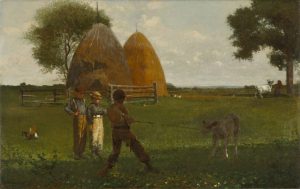The Trouble with Bachelard

I first encountered the poetics of the imagination the year I graduated from college and it could not have happened at a better time. Teaching on a Fulbright in a French lycée, word of mouth led me to attend an informal workshop in art theory and practice in a dusty classroom off the courtyard, taught by Jean Lancri, a colleague in the English department, and as it happened, a brilliant painter who was also at the time completing doctoral work under Jacques Derrida.1
Each week we were asked to engage pictorially with what we saw as the key notions in play in a brief excerpt from a work of philosophy or theory. A passage from Gaston Bachelard (fig. 1) paired with an exercise involving images of flight (comparing a rationalized Renaissance image of angels sprouting wings from their shoulders to a contemporary advertisement in which ecstatic flight inspired by some commodity took form in a more purely imagined liftoff representing flight as separation from the ground) awakened in me a style of analytic insight that continues to inform the art history I practice, yet has also been a source of persistent frustration.2

I would eventually devote several years to producing critical editions and translations of works by Bachelard—his posthumous Fragments of a Poetics of Fire; a major early work, Earth and Reveries of Will; and I have also published essays and articles featuring Bachelardian analysis.3 The first instance involved a return to this phenomenology of flight in reading a portrait landscape by Charles Bird King, Keokuk, the Watchful Fox (fig. 2), commissioned by the War Department, featuring a radical discontinuity between the narrow ledge of reddish earth where the eponymous figure stands facing the viewer and the cooler tonal harmonies beyond, a distance of water and picturesque mountains from which the foreground has been radically divided by a sheer drop into the valley below. This dramatic recuperation of Keokuk’s impending fall to offer reassurance of his possible apotheosis relies on a potent visual allegory in which the presence at the line of the cliff edge of Keokuk’s winged calves, like the talaria associated in the ancient world with winged Hermes, rescripts the prospect of his uncontrolled descent as the possibility of flight and of salvation—a moral axis of redemption reinforced by the strong line of his lance, which planted on the ground, points up into the heavens.4

A number of years later, inspired by the Bachelardian claim that “tout eau est un lait” [all water is a sort of milk],5 I found myself arguing that in early Winslow Homer (fig, 3) the interrupted circulation of mother’s milk variously served as a metaphor for the trauma of Reconstruction, for the heightened alienation of male adolescents, white as well as black, from their fathers, and for Homer’s abandoning of the pastoral for the naturalism to which he turned in the same period (the 1870s).6
Despite the College Art Association (CAA) endorsement of or at least sponsorship of these claims, the first of which appeared in a conference paper, the second in Art Bulletin, the session proposals I have submitted in a sort of dark ritual every few years have never succeeded in convincing a CAA program committee to sponsor a session on the impact of Bachelardian theory on art history and visual cultural.7 Bachelard, true, was never particularly interested in historical or visual analysis, and following his first career as a historian of science, was hardly a systematic thinker.8 He tended to communicate his insights in pithy poetic aperçus more like Luc de Clapiers, Marquis de Vauvenargues than Maurice Merleau-Ponty. His close friend, the poet Jean Lescure, years ago compiled a list of personal favorites. Here are seven: Le monde reflété est la conquête du calme [The world in reflection is the triumph of tranquility]; Le principe de la profondeur c’est la solitude [The principle of depth is solitude]; La main vide, les choses sont trop fortes [Empty-handed, the world is too much for us] Dans l’ordre de la matière, le oui et le non se disent mou et dur [In the material realm, yes and no read as soft and hard]; L’intérieur de l’objet petit est grand [The interior of the tiniest object is enormous]; Tout ce qui est rond apelle la caresse [Anything round attracts one’s caress]; and Tous les objets droits désignent un zénith [Anything upright calls attention to a zenith]. These translations are just that: somewhat flatfooted approximations that are also suggestive. What these aphorisms share is phenomenological insight: attention to the way in which the world takes shape in the imagination. For Bachelard, they map a principally literary phenomenon motivated by the capacity of language freed of its ties to responsibility for making literal sense to create something new. Happily, that is just what makes the visual arts so interesting, at least to me: their propensity for metaphor, for structural and spatial suggestion.
What might a CAA session devoted to Bachelard’s impact look like? The simplest version might involve papers by art historians from any area of the field presenting historical analyses of particular works in any genre informed by Bachelardian ideas. The more interesting version might double this session with a second in which artists working in all media, similarly influenced—and I have been approached by quite a number over the years, beginning with Lancri himself—might analyze the nature of that influence. All papers in both sessions ideally would combine a specificity of local analysis with a contribution to the larger project of assessing the place of Bachelardian poetics in the visual arts and their analysis today.
DOI: https://doi.org/10.24926/24716839.1569
PDF: Haltman, The Trouble with Bachelard
- See Jean Lancri, Y et K: Essai sur la peinture au risque de la lettre (Paris: Méridiens-Klincksieck, 1989). Lancri served for years as director of Arts plastiques et sciences de l’art at Université Paris 1, Panthéon-Sorbonne. ↵
- See Gaston Bachelard, Chapter 2: “La poétique des ailes,” in L’Air et les songes: essai sur l’imagination du movement (Paris: José Corti, 1948), 79–106. For Lancri’s own expanded take on this subject (treating works by Marc Chagall, Matthias Grünewald, and Fra Angelico), see his chapter 5, “Où l’index se fait oiseau pour nous projeter en plein ciel,” in L’index montré du doigt: Huit plus un essais sur la surprise en peinture (Paris: L’Harmattan, 2000), 139–74. ↵
- Kenneth Haltman, Fragments of A Poetics of Fire, critical translation of Gaston Bachelard, Fragments d’une poétique du feu,1958–1961 (Presses Universitaires de France, 1988), Dallas Institute of Humanities and Culture, 1991; Earth and Reveries of Will, critical translation of Gaston Bachelard, La Terre et les rêveries de la volonté (José Corti, 1947), Dallas Institute of Humanities and Culture, 2002. ↵
- See an unpublished talk, Kenneth Haltman, “The Art of Indian Affairs: Land and Sky in Charles Bird King’s Keokuk, The Watchful Fox,” annual meeting of the College Art Association, Chicago, February 14, 1992, a revised version of which will appear in Haltman, Artists and Hunters: Figures of Predatory Looking in American Art, in the works. ↵
- See Gaston Bachelard, Chapter 5: “L’eau maternelle et l’eau féminine,” in L’eau et les rêves: essai sur l’imagination de la matière (Paris: José Corti, 1942), 158. ↵
- See Kenneth Haltman, “Antipastoralism in Early Winslow Homer,” Art Bulletin 80 (March 1998): 93–112, esp. 99–105. See also Haltman, “Flight and Predation: The Anti-Documentary Poetics of Alfred Jacob Miller,” American Art 28 (Spring 2014): 32–55, a study of the role of flight in the work of Alfred Jacob Miller. ↵
- Jean Lescure, Un été avec Bachelard (Paris: Luneau Ascot, 1983), 166–70. ↵
- See, for instance, Kenneth Haltman, “Relire et traduire: la découverte du sens caché dans le texte bachelardien,” in Bachelard dans le monde, eds. Jean Gayon and Jean-Jacques Wunenburger (Paris: Presses Universitaires de France, 2000), 67–75. ↵
About the Author(s): Kenneth Haltman is Professor at the School of Visual Arts, University of Oklahoma.

